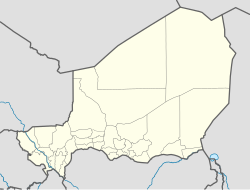Kelakam, Niger
Kelakam
Kélakam | |
|---|---|
| Coordinates: 13°33′22″N 11°44′27″E / 13.55611°N 11.74083°E | |
| Country | |
| Region | Diffa |
| Department | Maïné-Soroa |
Kelakam is a town in the Diffa Region, Maine-Soroa Department of southeastern Niger.
Location[edit]
It lies on the RN1 east–west highway of which runs between Diffa and Niamey, about halfway between the larger towns of Goudoumaria to the west and Maine-Soroa to the southeast. The town lies around 150 km west-northwest from the regional capital of Diffa.
Agro-pastoral centre[edit]
Situated in the Sahel region, the area around Kelakam is used for stock raising (cattle, goats, camels)[1] much of which involves seasonal transhumance, and intensive farming of cuvettes—rocky sinkholes which collect water in an otherwise dry land. Kelakam hosts a Saturday market.[2]
Kelakam is one site of ethnic Fula[3] pastoralist cooperatives formed as part of the UNDP "Nguigmi Peace Project". The project is designed to re-integrate former refugees and combatants from long simmering ethnic conflicts between Fula herders, and their Diffa Arab and Daza/Tubu neighbours over pasturage, water, and other land use. Fula pastoralists based around the town raise sheep and goats, and produce cheese and other agricultural products.[4]
References[edit]
- ^ Etude analyse des acquis de la filière santé animale, de l’organisation des éleveurs et de la couverture des besoins en eau de l’arrondissement[permanent dead link]; KARKARA / AFVP, Projet de développement de l'élevage – Maïné Soroa; 2003
- ^ Étude sur l'inventaire et la caractérisation pédologique et hydraulique des cuvettes oasiennes dans le département Maïné Soroua, REDES/ Etude Filières agricoles et forestières / PAGRN; KARKARA project (Niger), April 2004.
- ^ French: Peul; Fula: Fulɓe
- ^ Repartir de zéro – English Summary Archived 8 January 2009 at the Wayback Machine, UNV.org/UNDP, 4 December 2002.

